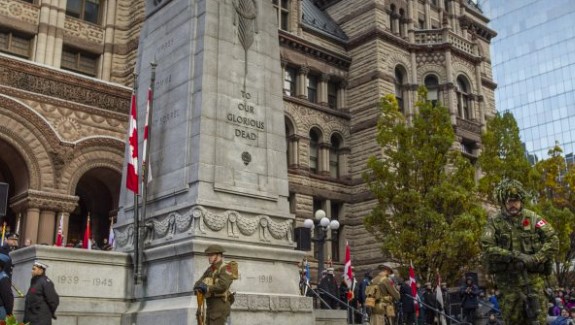
Days of Significance – National Commemorative Days
National Commemorative Days
The City of Toronto joins governments and cities across the country in commemoration and memorial on eight dates each year.
Each of these days is also commemorated with the half-masting of flags at Toronto City Hall and the Civic Centres.
Visit Half-Masting 2022 for details.

On December 6, 1989, 14 women were massacred, and ten others were injured at École Polytechnique in the Université de Montréal.
To commemorate the lives of women lost on that date and since that time,The National Day of Remembrance and Action on Violence Against Women was established by the Parliament of Canada in 1991 as a non-statutory observance. It is also known informally as White Ribbon Day.
The National Day of Remembrance and Action on Violence against Women is observed to honour those who have experienced gender-based violence. It is a day to reflect on the event in the hope of preventing further violence against women.
The City of Toronto has resources on Violence at Home and Intimate Partner Violence on its website.

Vimy Ridge Day commemorates the deaths and casualties of members of the Canadian Corps in the Battle of Vimy Ridge from April 9-12,1917 during the First World War. There were 3,598 Canadians who were killed (114 of them were from Toronto alone, the highest death toll of the First World War) and 7,004 Canadians were wounded during the battle. It is considered Canada’s most notable military victory and is often thought to symbolize the birth of Canadian national pride and identity. It was one of the first occasions when Canadian troops fought together as a singular entity.
Parliament passed the Vimy Ridge Day Act in 2003, and the date is marked annually as a non-statutory observance.
A Toronto Archives exhibit highlights the 1936 Toronto pilgrimage to Canadian National Vimy Memorial in France.
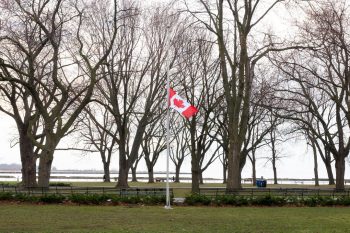
Credit: City of Toronto photographer
In 2021, at Coronation Park, which is a living memorial to the First World War, the City of Toronto raised a Canadian Flag that flew November 2020 during Remembrance Week at the Canadian National Vimy Ridge Memorial in France.
Watch a video of the flag raising.
Workers’ Mourning Day was proposed by the Canadian Labour Congress in 1984 to mark those who are killed or injured in the workplace.
In 1991 the Parliament of Canada passed the Workers Mourning Day Act making April 28 an official day of mourning as a non-statutory observance.
This day is now marked in more than 100 countries worldwide.
Every year on April 28 the City of Toronto commemorates the National Day of Mourning for persons killed, injured, or for those who have suffered illnesses resulting from incidents in the workplace. This date also provides an opportunity to renew our commitment to preventing future workplace tragedies.
On June 23, 1985, Air India Flight 182 was downed in the Atlantic Ocean off the coast of Ireland.

In response to this terrible tragedy, in 2005, the Governor General proclaimed June 23 as the National day of Remembrance for Victims of Terrorism. On this day, Canadians honour the memory of all victims of terrorism and denounce terrorism.
On board the Air India Flight were 329 people, including 280 Canadian citizens, along with citizens of the U.K., India, and other nations. Sadly, there were no survivors. Around the same time, another bomb exploded on an aircraft in Japan, claiming two lives at the Tokyo airport. In Toronto, all of these lives are memorialized by a monument in Humber Bay Park East. Many of the Canadian victims lived in Toronto or the Greater Toronto Area. The memorial is one of four in Canada in memory of the victims.
Wreath-laying at the Air India Flight 182 Memorial
On June 23, 2020, on the 35th anniversary of the Air India Tragedy, the Mayor accompanied by a representative of the families, placed a wreath at the Memorial in memory of those whose lives were lost.
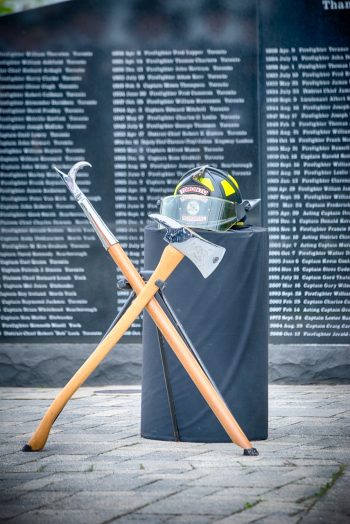
Across Canada, more than 1,000 firefighters have died in the line of duty since 1848.
As a tribute to the firefighters who risk their lives to keep Canadians safe, the second Sunday in September was selected to honour the memory of firefighters who have lost their lives because of their work. This date was established in 2017 by proclamation of the Governor General of Canada.
Firefighters’ National Memorial Day commemorates the courage, selflessness, and unwavering commitment of firefighters who serve their communities. It is also a recognition of the dangers firefighters often face when carrying out their duties, and the sacrifice of firefighters who have given their lives for others.
The City of Toronto honours Toronto Firefighters who have died in the line of duty since 1848 through the Toronto Fire Memorial Wall.
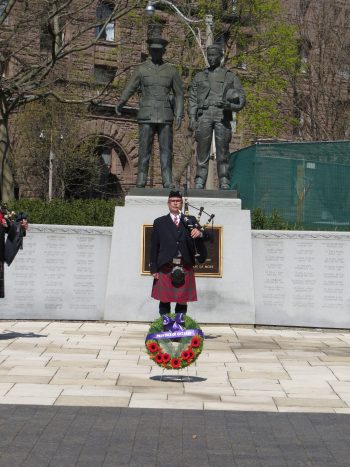
More than 800 Canadian police officers have been killed in the line of duty since 1867. The last Sunday in September was selected to honour these lives with a national ceremony. In 1998, the Governor General of Canada proclaimed the last Sunday of September every year as Police and Peace Officers’ National Memorial Day, in honour of fallen officers. Over 800 police officers have been killed in the line of duty since 1867.
Police and peace officers make important contributions to the safety of their communities. Each year this day commemorates those police and peace officers who were killed in the line of duty and pays tribute to their dedication and the sacrifices. Members of the Toronto Police Service regularly attend the National Memorial ceremony in Ottawa on this date and flags at Police stations and buildings are half-masted.
For those who have fallen in Toronto since 1901, view the Toronto Police Service Memorial and Honour roll.
The National Day for Truth and Reconciliation (also known as Orange Shirt Day) is a day set aside to commemorate the ongoing trauma caused by residential and day schools, and remember those who were lost, the survivors and their families. The day was established by the Parliament of Canada in 2021 as a statutory holiday for the federal government and businesses which are federally regulated.
Orange Shirt Day has been observed since 2013, as part of an effort to promote awareness and education of the residential school system and the impact it has had on Indigenous communities for over a century.
View the City of Toronto’s commemorative activities.
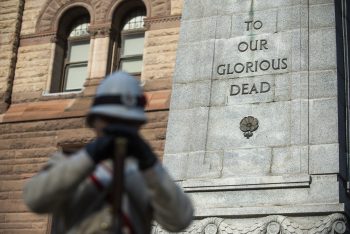
Remembrance Day is observed across Canada each year on November 11 — the anniversary of the Armistice agreement of 1918 that ended the First World War. Remembrance Day is marked annually in many Commonwealth countries, including Canada, to remember those who died in military service in world wars and other conflicts. More history on Armistice Day in Toronto, now known as Remembrance Day, can be found in this exhibit from Toronto Archives.
Remembrance Day is a federal statutory holiday that was established by Parliament in 1931. Prior to that, it was observed on the Monday in the week in which November 11 fell. On Remembrance Day, public ceremonies are held, and Canadians observe two minutes of silence at 11 am to honour the more than 100,000 who gave their lives in service to Canada. Wreaths are laid at cenotaphs and assemblies are held in schools.

